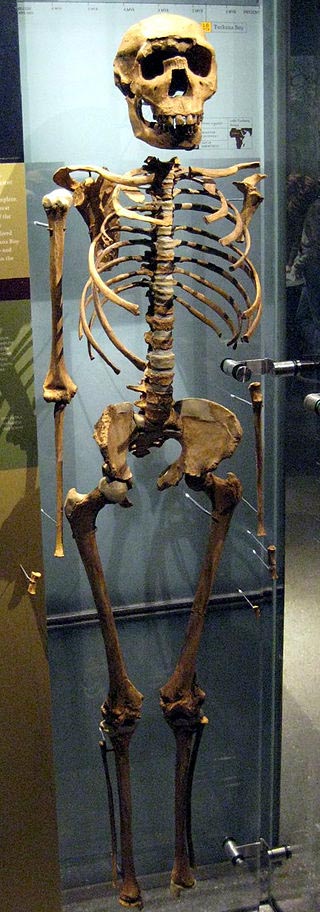



Turkana Boy, now called, Nariokotome Boy, is the common name of fossil KNM-WT 15000,[nb 1] a nearly complete skeleton of a hominid who died in the early Pleistocene. This specimen is the most complete early human skeleton ever found. It is believed to be between 1.5 and 1.6 million years old. The skeleton was discovered in 1984 by Kamoya Kimeu, a member of a team led by Richard Leakey, at Nariokotome near Lake Turkana in Kenya.
His age has been estimated from 7 years and 6 months to as old as 15 years. The most recent scientific review suggests 8 years of age. It was initially suggested that he would have grown into a 185 centimetres (73 in) tall adult but the most recent analysis argues for the much shorter stature of 163 centimetres (64 in). The reason for this shift has been research showing that his growth maturation differed from that of modern humans in that he would have had a shorter and smaller adolescent growth spurt.
Turkana Boy is classified as either Homo erectus or Homo ergaster. The shape of the pelvis indicates that it was a male. Based on dental eruption and lack of any epiphyseal union of the skull, anthropologists Tim White and Richard Leakey determined the boy to have been about 12 years old. Other authorities, however, consider that since H. erectus matured faster than modern humans, the boy was actually about 9 years old. Common chimpanzees (Pan troglodytes, for example) mature more quickly than Homo sapiens. Anatomist Raymond Dart discovered the first gracile australopithecine species (Australopithecus africanus) in 1924 in the Taung limestone quarry in South Africa. Tests have shown that A. africanus (Taung child) developed more quickly into adulthood like modern apes.
Turkana Boy appears to have matured at a rate in between modern humans and apes. Other fossils attributable to Homo erectus, Homo heidelbergensis, and Homo neanderthalensis show signs of an increasingly larger birth canal in the female, enabling mothers to give birth to larger brained infants in comparison to modern apes and australopithecines.
The skeleton was about 1.60 m (5 ft 3 in) tall, although he might have been 68 kg (150 lb) and 1.85 m (6 ft 1 in) tall had he lived to adulthood. The total skeleton is made up of 108 bones accounted for. The cranial capacity of Turkana Boy was about 880 cc, although if he had lived to adulthood, it would have been about 910 cc, which is considerably smaller than the 1350 cc cranial capacity of modern humans.
There are several features which seem awkward in comparison to modern humans. The pelvic structure is narrower than in modern Homo sapiens, meaning that Homo ergaster and Homo erectus in both Africa and Asia had a greater ability to run. Their running techniques may have been equivalent to a modern day race track athlete. This hints that the species lived a harsh and demanding lifestyle; most importantly they must have been accomplished hunters rather than scavengers such as Homo habilis. Radical changes are believed to have taken place during the transformation between the australopithecines and Homo species. Because of Homo ergaster's greater height and limb proportions, which are more similar to Homo sapiens than to the ape-like australopithecines, a combination of height and likely absence of fur would have been a necessity.
From 2 million years ago onwards, a cool dark skin would have helped protect these hominins from deadly ultraviolet radiation from the sun. In equatorial Africa, modern humans evolved this trait an estimated 1 million years ago. The loss of thick fur enabled the sweating mechanism to cool the body down to the required 37 °C. The melanin development would have become crucial to surviving in open land. This coloring of the skin is still present in equatorial populations of modern Homo sapiens.
The overall body stature, weight, and proportions coincidentally are somewhat similar to today's ethnic Masai (also known as Maasai) peoples living in modern day Kenya. Tall dark slender bodies keep the body cool by perspiration. However, the similarity should not be taken to be too great. The overall KNM-WT 15000 skeleton still had features (such as a low sloping forehead, strong brow ridges, and the absence of a chin) not seen in present day modern humans. The arms of the species were slightly longer than seen in modern-day humans. It is currently believed that Turkana Boy had a projecting nose rather than the open flat nose-structure seen in apes and possibly acquired in australopithecines. The larger protruding nose helped to keep in moisture at a balanced temperature, cooling the blood in hot arid areas. The opposite could be said for Homo neanderthalensis (Neanderthals), who had unusually large nostrils which would warm and humidify cold and dry air before it reached the throat and lungs.
The fossil skeleton and much other fossil evidence such as Acheulean stone tools prompts the majority of scientists to conclude that Homo ergaster and Homo erectus, unlike their more primitive ancestors, became efficient hunters. The social structure would probably have become more complex with a larger brain volume; the Broca's area of the brain allows speech and is noted by a slight slant on the cranium. Some anthropologists believe that simplistic sounds lead to modern language. However, there are contradictory views on the notion of language. It remains controversial when modern human sounds and basic verbs first became used. The various possibilities include:
1.5 million years ago, on the arrival of several distinct more human-like hominins spread throughout Africa, Europe, and Asia (i.e., Homo erectus).
600,000 and 150,000 years ago when archaic Homo sapiens dominated regions in the Pleistocene epoch (several members during this period are considered fully modern Homo sapiens).
50,000 years ago (fully modern Homo sapiens had already spread though the Old World and slowly into the New World 20,000 BCE). Some believe language coincided solely with modern humans once culture was established by groups such as Cro-Magnon man in Europe. It is still a matter of debate whether Neanderthals had a modern form of language.
Richard Leakey also mentions in his book Origin of Humankind (1995) that Turkana Boy's thoracic vertebrae is narrower than in modern Homo sapiens's, meaning that he could not make complex speech due to less air being received into his lungs. Read more
Turkana stone beads tell a story of herder life in a drying east Africa 5,000 years ago PhysOrg - November 9, 2023
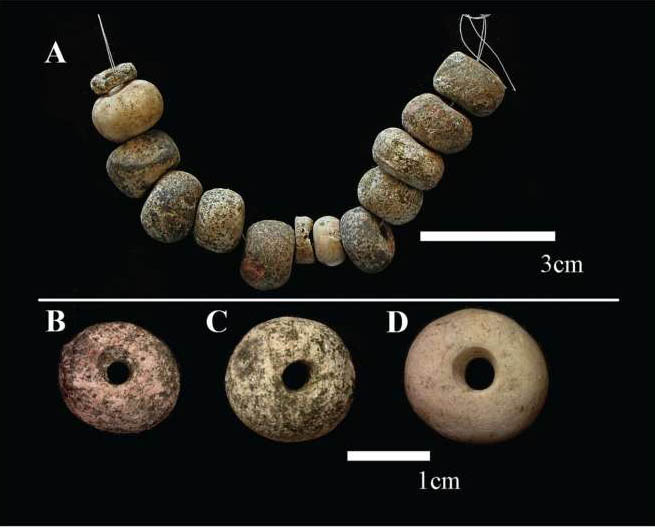
On the shores of Lake Turkana in east Africa, about 5,000 to 4,000 years ago, pastoralists buried their dead in communal cemeteries that were marked by stone circles and pillars. The north-west Kenya "pillar sites" were built around the same time as Stonehenge in the UK. But these places have a different story to tell: about how mortuary traditions reflect people's environments, behaviors and reactions to change.
Turkana Boy sparks row over Homo erectus height Science News - April 14, 2014
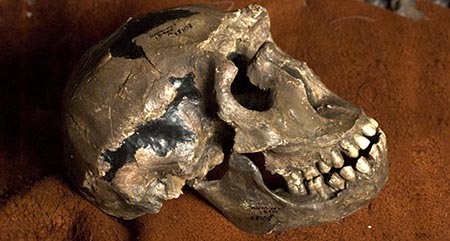
A Stone Age boy stands at the center of a controversy over when members of the human evolutionary family first reached heights and weights comparable to those of modern human adults. All that remains of the ancient, approximately 8-year-old Homo erectus boy today is his nearly complete roughly 1.5-million-year-old skeleton. Excavations in 1984 near Kenya's Lake Turkana yielded the find, often called Turkana Boy. At the time of the skeleton's excavation, little was known about adult sizes and growth patterns of H. erectus.
When he died, the child stood roughly 5 feet, 3 inches. A study from 1993 estimated that, had Turkana Boy lived, he would have grown to a height of 6 feet, 1 inch and weight of around 150 pounds. If the boy really was destined for such tallness, then H. erectus would have experienced an adolescent growth spurt on a par with modern humans. A transition to humanlike growth and development would have occurred surprisingly early in hominid evolution. New comparisons of Turkana Boy's teeth to those of modern chimpanzees and gorillas at various ages indicate that the child would have reached an adult height of between 5 feet, 9 inches and 5 feet, 11 inches, reported Christopher Ruff at the American Association of Physical Anthropologists annual meeting on April 10.
Best-Preserved Human Ancestor Didn't Have Bone Disorder Live Science - March 19, 2013
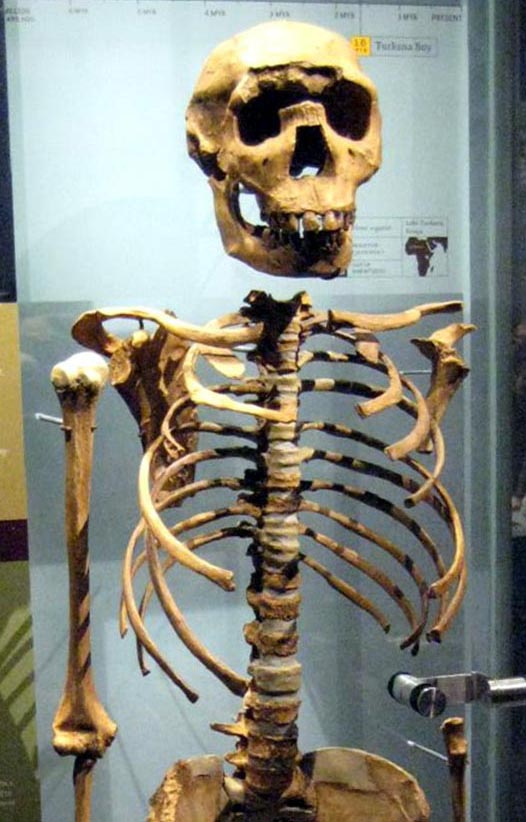
"Turkana Boy," an exquisitely preserved 1.5-million-year-old human ancestor found in Kenya, may not have had dwarfism or scoliosis, new research suggests. Past studies had suggested that the ancient human ancestor, a Homo erectus, had suffered from a congenital bone disorder that made him unrepresentative of his species. New analysis, published in the March issue of the American Journal of Physical Anthropology, suggests that apart from a herniated disc in his back, Turkana Boy was a fairly healthy person with no genetic bone problems.
'Turkana Boy' Skeleton Stirs Debate -- Discovery - February 7, 2007
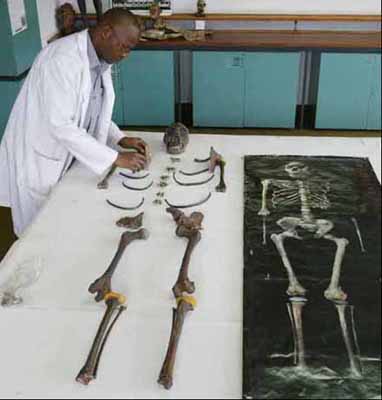
Deep in the dusty, unlit corridors of Kenya's national museum, locked away in a plain-looking cabinet, is one of mankind's oldest relics: Turkana Boy, as he is known, the most complete skeleton of a prehistoric human ever found.
But his first public display later this year is at the heart of a growing storm - one pitting scientists against Kenya's powerful and popular evangelical Christian movement.
The debate over evolution vs. creationism - once largely confined to the United States - has arrived in a country known as the cradle of mankind. "I did not evolve from Turkana Boy or anything like it," says Bishop Boniface Adoyo, head of Kenya's 35 evangelical denominations, which he claims have 10 million followers. "These sorts of silly views are killing our faith."
He's calling on his flock to boycott the exhibition and has demanded the museum relegate the fossil collection to a back room - along with some kind of notice saying evolution is not a fact but merely one of a number of theories. Against him is one of the planet's best-known fossil hunters, Richard Leakey, whose team unearthed the bones at Nariokotome in West Turkana, in the desolate, far northern reaches of Kenya in 1984. "Whether the bishop likes it or not, Turkana Boy is a distant relation of his," Leakey, who founded the museum's prehistory department, told The Associated Press. "The bishop is descended from the apes and these fossils tell how he evolved."
Among the 160,000 fossils due to go on display is an imprint of a lizard left in sedimentary rock, dating back 200 million years, at a time when the Earth's continents were only beginning to separate. Dinosaur fossils and a bone from an early human ancestor, dating back 7 million years, will also be on show along with the bones of short-necked giraffes and elephants whose tusks protrude from their lower jaws. They provide the clearest and unrivaled record yet of evolution and the origins of man, say scientists. But the highlight will be the 5-foot-3 Turkana Boy, who died at age 12 and whose skeleton had been preserved in marshland before its discovery.
Followers of creationism believe in the literal truth of the Genesis account in the Bible that God created the world in six days. Bishop Adoyo believes the world was created 12,000 years ago, with man appearing 6,000 years later. He says each biblical day was equivalent to 1,000 Earth years. Adoyo's evangelical coalition is the only religious group voicing concern about the exhibition. Leakey fears the ideological spat may provoke an attack on the priceless collection, one largely found during the 1920s by his paleontologist parents, Louis and Mary Leakey, who passed their fossil-hunting traditions on to him.
ANCIENT AND LOST CIVILIZATIONS